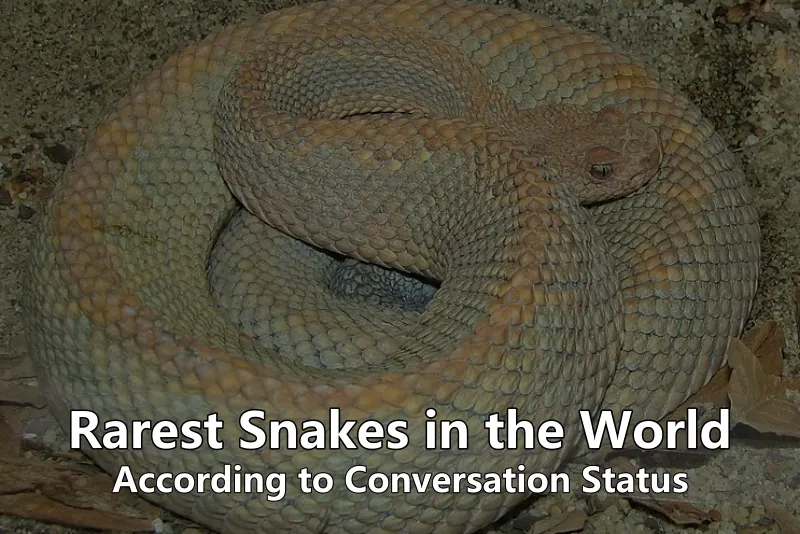Snakes are carnivorous reptiles from the suborder Serpentes. There are more than 3,900 species of snakes globally, with diverse sizes ranging from 10.4 cm to 12.8 meters long. In this post, we have ranked the Top 20+ Rarest snakes in the world according to the conversation status.
Here, we have tried to cover nearly all critically endangered snake species endemic to particular regions. So, without any further ado, let’s discuss the list of rarest snakes globally.
Top 20+ Rarest Snakes in the World
21) Trang Blind Snake and Roxane’s Blind Snake
| Scientific Name | Argyrophis trangensis & Argyrophis roxaneae |
| Size | 20-23.1 cm |
| Life Span | 4-20 years |
| Location | Thailand |
| Toxicity | Non-Venomous |
| Conservation Status | Data Deficient |
Let’s begin the list of rarest snakes in the world with Trang Blind Snake and Roxane’s Blind Snake. These two snakes are two different species that are incredibly rare.
We mentioned their names at one point because of a lack of information about them. They both are from Typhlopidae family. These two snakes are so rare that they have been seen only one time (when they were discovered). It’s very difficult to find them.
20) Spider-tailed horned viper
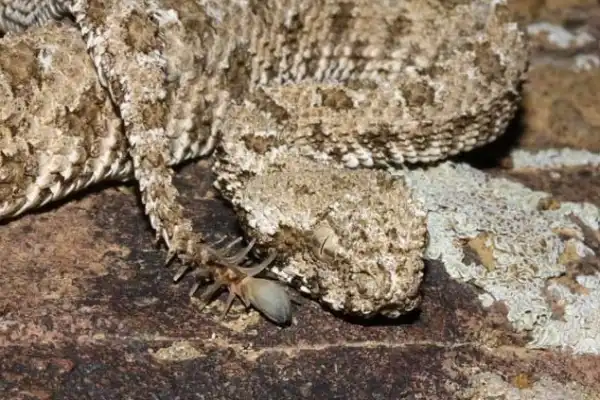
| Scientific Name | Pseudocerastes urarachnoides |
| Size | 50-53.1 cm |
| Life Span | 10-14 years |
| Location | Gilan-e Gharb, Iran |
| Toxicity | Venomous |
| Conservation Status | Near Threatened |
Spider-tailed horned viper, also known as spider snake, is one of the venomous snakes from the family Viperidae (Vipers). It has a unique tail that looks like a spider.
It uses its tail to lure birds, and its rough brown scales with horns provide it with camouflage. These snakes can be found in various regions of Iran.
19) Round Island Boa
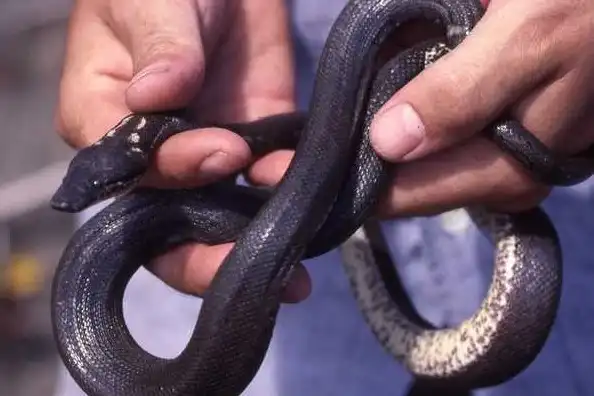
| Scientific Name | Casarea dussumieri |
| Size | up to 150 cm |
| Life Span | 10-20 years |
| Location | Round Island, Mauritius |
| Toxicity | Non-Venomous |
| Conservation Status | Vulnerable |
Round Island boa, also known as the Round Island keel-scaled boa, is a non-venomous snake from the family Bolyeriidae.
Their body is covered with small-keeled scales, and they are primarily active at night. It may grow up to 150 cm and can be found on the islands of Gunner’s Quoin.
18) Alcatrazes lancehead
| Scientific Name | Bothrops alcatraz |
| Size | 40-50 cm |
| Life Span | 20-25 years |
| Location | Ilha Alcatrazes, São Paulo, Brazil |
| Toxicity | Venomous |
| Conservation Status | Vulnerable |
Alcatrazes lancehead is a venomous snake from the species pitviper. The species is categorized under the vulnerable conversation status and can only be found on the southeastern coast of Brazil. They have a petite body size and can grow a maximum of up to 50.5 cm.
17) Bolo Snake
| Scientific Name | Ogmodon vitianus |
| Size | 40-50 cm |
| Life Span | No Information |
| Location | Viti Levu Island, Republic of Fiji |
| Toxicity | Venomous |
| Conservation Status | Endangered |
Bolo Snake, also known as Fiji Snake (Ogmodon vitianus), is from the family Elapidae. It is one of the rarest snakes in the world and is also distinguished as an endangered species. Bolo Snake can only be found on the island of Viti Levu in the Republic of Fiji.
16) Cropani’s tree boa
| Scientific Name | Corallus cropanii |
| Size | 150-170 cm |
| Life Span | 10-20 years |
| Location | Miracatu, State of São Paulo, Brazil |
| Toxicity | Non-Venomous |
| Conservation Status | Endangered |
Cropani’s tree boa, also known as Corallus cropanii, is one of the endangered species of boa. It is from the family Boidae.
It is non-venomous and has more than 30 dorsal scales in rows over their bodies. It is primarily found in the coastal plain of Brazil.
15) Cuban khaki dwarf boa
| Scientific Name | Tropidophis hendersoni |
| Size | 200-300 cm |
| Life Span | 10-20 years |
| Location | West Indies |
| Toxicity | Non-Venomous |
| Conservation Status | Endangered |
Cuban khaki dwarf boa is one of the rarest snakes in the world. It is from boa species that are only found in the West Indies.
It is also categorized under endangered species. They can grow up to 3 feet long.
14) Sahul reef snake or Short-nosed sea snake
| Scientific Name | Aipysurus apraefrontalis |
| Size | 50-60 cm |
| Life Span | 8-10 years |
| Location | Ashmore & Cartier Islands and the Ningaloo Reef, Australia |
| Toxicity | Venomous |
| Conservation Status | Data Deficient |
Sahul reef snake, also known as Short-nosed sea snake or Aipysurus apraefrontalis, is one of the critically endangered venomous sea snake species from the family Elapidae.
These slender brown snakes have small pointed heads and purplish-brown bands over their body. It may grow up to 60 cm and can be found in the Northwestern region of Australia.
13) Wagner’s viper
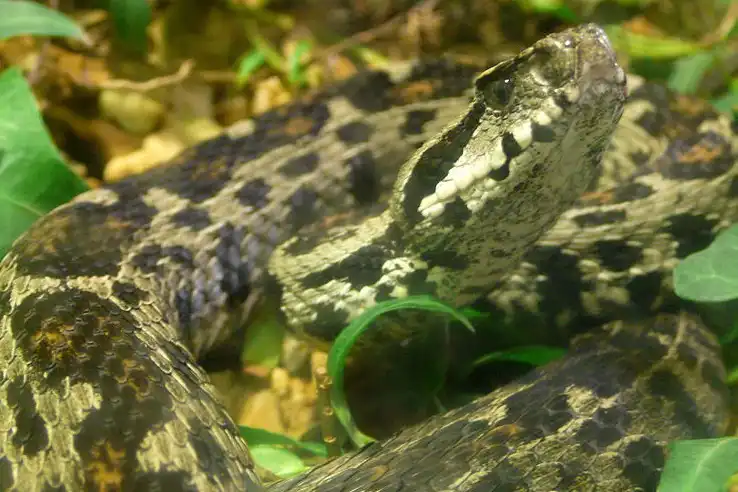
| Scientific Name | Montivipera wagneri |
| Size | 70-95 cm |
| Life Span | 10-20 years |
| Location | Lake Urmia, Iran & Eastern Turkey |
| Toxicity | Venomous |
| Conservation Status | Critically Endangered |
Wagner’s viper, also known as ocellate mountain viper, is one of the critically endangered venomous viper species from the family Viperidae.
It has a greyish ground color body covered with small keeled scales of yellowish-brown or orange colors with black borders. It can grow up to a maximum length of 95 cm. It is only found in eastern Turkey and northwestern Iran.
12) Leaf-scaled Sea Snake
| Scientific Name | Aipysurus foliosquama |
| Size | up to 80 cm |
| Life Span | No information |
| Location | Shark Bay on the western coast of Australia |
| Toxicity | Venomous |
| Conservation Status | Data Deficient |
Leaf-scaled Sea Snake, another name Aipysurus foliosquama, is one of the rarest venomous sea snake species. It is from the family Elapidae and has purple-brown scales.
It may grow up to 800 millimeters and can be found at Shark Bay on the western coast of Australia.
11) Darevsky’s viper
| Scientific Name | Vipera darevskii |
| Size | 28-42 cm |
| Life Span | 10-20 years |
| Location | northwestern Armenia, northeastern Turkey |
| Toxicity | Venomous |
| Conservation Status | Critically Endangered |
Darevsky’s viper, another name Vipera darevskii, is one of the critically endangered venomous viper species from the family Viperidae.
It is a relatively small snake species with a 42.1 cm maximum length, but its bite is too painful and life-threatening even for adult humans. It is light brown with a black zigzag pattern all over its body.
10) Kikuzato’s brook snake
| Scientific Name | Opisthotropis kikuzatoi |
| Size | 28-42 cm |
| Life Span | 10-20 years |
| Location | Kumejima Island, Japan |
| Toxicity | Venomous |
| Conservation Status | Critically Endangered |
Kikuzato’s brook snake is the rarest snake in the world from the family Colubridae. It is semiaquatic species endemic to Kumejima Island, Japan.
It has a dark-shine body with a small head and mainly feeds on earthworms, freshwater shrimp, freshwater fishes, tadpoles, and frogs.
9) Aruba Island Rattlesnake

| Scientific Name | Crotalus unicolor |
| Size | up to 90 cm |
| Life Span | 15-20 years |
| Location | Aruba |
| Toxicity | Venomous |
| Conservation Status | Critically Endangered |
Crotalus unicolor, also known as Aruba Island Rattlesnake, is one of the rarest venomous snakes in the world from pitviper species. It has a body weight of up to one kilogram and can grow approximately 90 cm.
Its body is light brown and pink in color with dark brown diamond-shaped markings. It can only be found on the island of Aruba.
8) Santa Catalina Rattlesnake
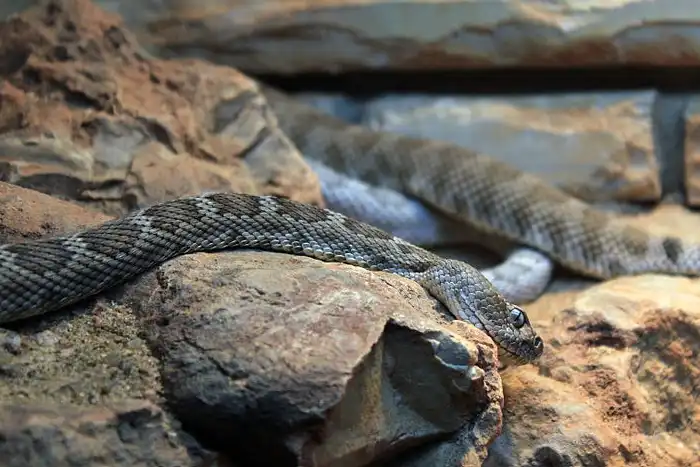
| Scientific Name | Crotalus unicolor |
| Size | up to 90 cm |
| Life Span | 15-20 years |
| Location | Isla Santa Catalina, Gulf of California |
| Toxicity | Venomous |
| Conservation Status | Data Deficient |
Another rarest venomous snake from pitviper species is Santa Catalina Rattlesnake, also called Crotalus catalinensis. It can grow up to 73.1 cm.
It has either a light cream-colored body with reddish-brown blotching or an ash-grey color body with darker grey blotching. This rattlesnake is mainly found in the Gulf of California.
7) Saint Vincent blacksnake
| Scientific Name | Chironius vincenti |
| Size | up to 101 cm |
| Life Span | No information |
| Location | Saint Vincent and the Grenadines |
| Toxicity | No information |
| Conservation Status | Critically Endangered |
Saint Vincent blacksnake, also called Saint Vincent coachwhip, is also categorized as the rarest snake because of its critically endangered conversation status.
It is from the family Colubridae and is endemic to Saint Vincent and the Grenadines. It can grow up to 101 cm in length and have a dark-brown body color.
6) Ross’ wolf snake
| Scientific Name | Lycodon chrysoprateros |
| Size | up to 72.7 cm |
| Life Span | up to 10 years |
| Location | Dalupiri Island, Philippines |
| Toxicity | Mildly venomous |
| Conservation Status | Critically Endangered |
Another critically endangered colubrid snake species is Lycodon chrysoprateros or Ross’ wolf snake. It can only be witnessed at Dalupiri Island in the Philippines.
It can grow up to 72.7 centimeters and has a dark brown dorsal surface without any pattern.
5) Golden Lancehead

| Scientific Name | Bothrops Insularis |
| Size | 70-90 cm |
| Life Span | up to 15 years |
| Location | Queimada Grande Island, Brazil |
| Toxicity | Venomous |
| Conservation Status | Critically Endangered |
Bothrops insularis, also known as Golden Lancehead, is one of the critically endangered venomous snakes from pitviper species. It has yellowish-brown body color with a size range from 70 cm to 90 cm.
It is also considered one of the most expensive snakes in the world. Golden Lancehead viper can only be seen in São Paulo state in Brazil.
4) Xenotyphlops grandidieri
| Scientific Name | Xenotyphlops grandidieri |
| Size | 15-27 cm |
| Life Span | 4-20 years |
| Location | Northern Madagascar |
| Toxicity | Non-Venomous |
| Conservation Status | Critically Endangered |
Xenotyphlops grandidieri, also known as Madagascar Blind Snake, is one of the critically endangered snake species from a blind snake or thread snake species.
It has a small body size covered with beautiful pink color. It can only be found in Northern Madagascar.
3) Antiguan Racer

| Scientific Name | Alsophis antiguae |
| Size | 90-100 cm |
| Life Span | up to 20 years |
| Location | Islands on the Antigua Bank |
| Toxicity | Non-Venomous |
| Conservation Status | Critically Endangered |
In the past, Antiguan Racer is categorized under the extinct status. But thanks to conservation efforts, these snakes have increased in number from 50 to 1100 within the span of 20 years.
Antiguan racer is a non-venomous grey-brown snake from the family Colubridae. It can be found on Great Bird Island, Rabbit Island, Green Island, and York Island off the coast of Antigua.
2) Vipera orlovi
| Scientific Name | Vipera orlovi |
| Size | 50+ cm |
| Life Span | 10-20 years |
| Location | Caucasus, Russia |
| Toxicity | Venomous |
| Conservation Status | Critically Endangered |
Vipera orlovi, also known as Orlov’s Viper, is also one of the rarest venomous snakes in the world. It can only be seen in the Caucasus area of Russia.
It is placed in the second position because of its decreasing population trend. Vipera orlovi has dark-brown body color with black shades.
1) Saint Lucia Racer
| Scientific Name | Erythrolamprus ornatus |
| Size | 50-90 cm |
| Life Span | No information |
| Location | Saint Lucia, West Indies |
| Toxicity | Non-Venomous |
| Conservation Status | Critically Endangered |
Saint Lucia racer, also called Ornate Ground Snake, is the rarest snake in the world, with fewer than 20 left globally. It can grow up to 123.5 cm in body length from head to tail.
Saint Lucia racer is a non-venomous snake that can only be discovered in Saint Lucia, West Indies. It has a brown cerebral stripe with alternating yellow spots.
Here, we conclude our article on “Top 20+ Rarest Snakes in the World (According to Conversation Status).” We hope you like this post. We will be back with another post. Till then, stay tuned with us and read the articles below.
Symbol used-
- 1 m = 100 cm
- 1 cm = 0.39 inches
- 1 foot = 30.48 cm
References
Image Source- Wikipedia, Live Science, Alchetron, EDGE of Existence
Also Read:

Meet Monty, the visionary founder of How It See, being an engineering student, he’s fueled by an insatiable curiosity about the world around him. He is captivated by an eclectic correlation between animal groups, science, and nature, and this fascination drives his quest for understanding.
After completing his degree, he’s set on a mission to delve deep into the realm of nature, accumulating knowledge to share with you through his writing. In the meantime, he loves to watch anime and read anime.
